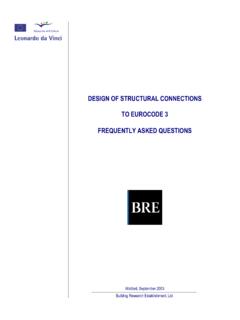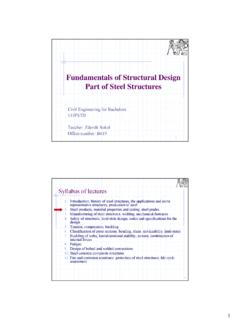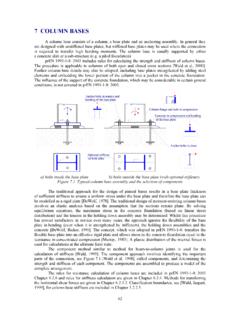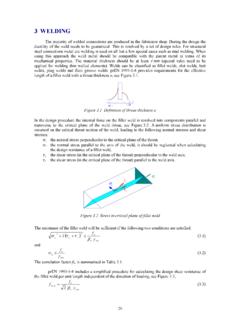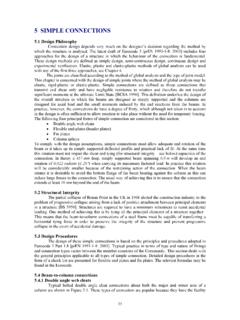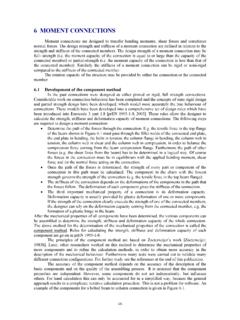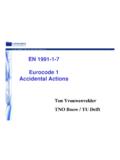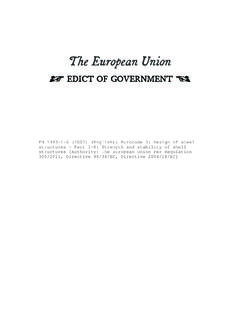Transcription of EN 1993-1-1:2005 - 64 e stf - cvut.cz
1 EUROPEAN STANDARD EN 1993 -1-1. NORME EUROP ENNE. EUROP ISCHE NORM May 2005. ICS ; Supersedes ENV 1993 -1-1:1992. English version eurocode 3: Design of steel structures - Part 1-1: General rules and rules for buildings eurocode 3: Calcul des structures en acier - Partie 1-1: eurocode 3: Bemessung und Konstruktion von Stahlbauten R gles g n rales et r gles pour les b timents - Teil 1-1: Allgemeine Bemessungsregeln und Regeln f r den Hochbau This European Standard was approved by CEN on 16 April 2004. CEN members are bound to comply with the CEN/CENELEC Internal Regulations which stipulate the conditions for giving this European Standard the status of a national standard without any alteration. Up-to-date lists and bibliographical references concerning such national standards may be obtained on application to the Central Secretariat or to any CEN member. This European Standard exists in three official versions (English, French, German).
2 A version in any other language made by translation under the responsibility of a CEN member into its own language and notified to the Central Secretariat has the same status as the official versions. CEN members are the national standards bodies of Austria, Belgium, Cyprus, Czech Republic, Denmark, Estonia, Finland, France, Germany, Greece, Hungary, Iceland, Ireland, Italy, Latvia, Lithuania, Luxembourg, Malta, Netherlands, Norway, Poland, Portugal, Slovakia, Slovenia, Spain, Sweden, Switzerland and United Kingdom. EUROPEAN COMMITTEE FOR STANDARDIZATION. COMIT EUROP EN DE NORMALISATION. EUROP ISCHES KOMITEE F R NORMUNG. Management Centre: rue de Stassart, 36 B-1050 Brussels 2005 CEN All rights of exploitation in any form and by any means reserved Ref. No. EN 1993 -1-1:2005: E. worldwide for CEN national Members. EN 1993 -1-1: 2005 (E). Contents Page 1 General.
3 9. 9. Normative 10. 11. Distinction between principles and application rules .. 11. Terms and definitions .. 11. 12. Conventions for member 20. 2 Basis of design .. 22. Requirements .. 22. Basic requirements .. 22. Reliability 22. Design working life, durability and robustness .. 22. Principles of limit state design .. 23. Basic variables .. 23. Actions and environmental 23. Material and product 23. Verification by the partial factor method .. 23. Design values of material properties .. 23. Design values of geometrical 23. Design 24. Verification of static equilibrium (EQU).. 24. Design assisted by 24. 3 25. General .. 25. Structural 25. Material 25. Ductility requirements .. 25. Fracture 25. Through-thickness properties .. 27. 28. Design values of material 28. Connecting devices .. 28. Fasteners .. 28. Welding 28. Other prefabricated products in buildings.
4 28. 4 Durability .. 28. 5 Structural 29. Structural modelling for analysis .. 29. Structural modelling and basic 29. 2. EN 1993 -1-1: 2005 (E). Joint modelling .. 29. Ground-structure 29. Global analysis .. 30. Effects of deformed geometry of the structure .. 30. Structural stability of frames .. 31. Imperfections .. 32. Basis .. 32. Imperfections for global analysis of frames .. 33. Imperfection for analysis of bracing systems .. 36. Member 38. Methods of analysis considering material non-linearities .. 38. General .. 38. Elastic global analysis .. 39. Plastic global 39. Classification of cross 40. Basis .. 40. Classification .. 40. Cross-section requirements for plastic global 41. 6 Ultimate limit 45. General .. 45. Resistance of cross-sections .. 45. General .. 45. Section properties .. 46. Tension .. 49. Compression .. 49. Bending moment .. 50. Shear .. 50.
5 52. Bending and shear .. 53. Bending and axial 54. Bending, shear and axial force .. 56. Buckling resistance of members .. 56. Uniform members in compression .. 56. Uniform members in 60. Uniform members in bending and axial compression .. 64. General method for lateral and lateral torsional buckling of structural 65. Lateral torsional buckling of members with plastic hinges .. 67. Uniform built-up compression members .. 69. General .. 69. Laced compression 71. Battened compression members .. 72. Closely spaced built-up 74. 7 Serviceability limit states .. 75. General .. 75. Serviceability limit states for buildings .. 75. Vertical 75. Horizontal 75. Dynamic 75. Annex A [informative] Method 1: Interaction factors kij for interaction formula in (4) .. 76. 3. EN 1993 -1-1: 2005 (E). Annex B [informative] Method 2: Interaction factors kij for interaction formula in (4).
6 79. Annex AB [informative] Additional design provisions .. 81. Annex BB [informative] Buckling of components of building structures .. 82. 4. EN 1993 -1-1: 2005 (E). Foreword This European Standard EN 1993 , eurocode 3: Design of steel structures, has been prepared by Technical Committee CEN/TC250 Structural Eurocodes , the Secretariat of which is held by BSI. CEN/TC250 is responsible for all Structural Eurocodes. This European Standard shall be given the status of a National Standard, either by publication of an identical text or by endorsement, at the latest by November 2005, and conflicting National Standards shall be withdrawn at latest by March 2010. This eurocode supersedes ENV 1993 -1-1. According to the CEN-CENELEC Internal Regulations, the National Standard Organizations of the following countries are bound to implement these European Standard: Austria, Belgium, Cyprus, Czech Republic, Denmark, Estonia, Finland, France, Germany, Greece, Hungary, Iceland, Ireland, Italy, Latvia, Lithuania, Luxembourg, Malta, Netherlands, Norway, Poland, Portugal, Slovakia, Slovenia, Spain, Sweden, Switzerland and United Kingdom.
7 Background of the eurocode programme In 1975, the Commission of the European Community decided on an action programme in the field of construction, based on article 95 of the Treaty. The objective of the programme was the elimination of technical obstacles to trade and the harmonization of technical specifications. Within this action programme, the Commission took the initiative to establish a set of harmonized technical rules for the design of construction works which, in a first stage, would serve as an alternative to the national rules in force in the Member States and, ultimately, would replace them. For fifteen years, the Commission, with the help of a Steering Committee with Representatives of Member States, conducted the development of the Eurocodes programme, which led to the first generation of European codes in the 1980s. In 1989, the Commission and the Member States of the EU and EFTA decided, on the basis of an agreement1.
8 Between the Commission and CEN, to transfer the preparation and the publication of the Eurocodes to the CEN through a series of Mandates, in order to provide them with a future status of European Standard (EN). This links de facto the Eurocodes with the provisions of all the Council's Directives and/or Commission's Decisions dealing with European standards ( the Council Directive 89/106/EEC on construction products CPD and Council Directives 93/37/EEC, 92/50/EEC and 89/440/EEC on public works and services and equivalent EFTA Directives initiated in pursuit of setting up the internal market). The Structural eurocode programme comprises the following standards generally consisting of a number of Parts: EN 1990 eurocode : Basis of structural design EN 1991 eurocode 1: Actions on structures EN 1992 eurocode 2: Design of concrete structures EN 1993 eurocode 3: Design of steel structures EN 1994 eurocode 4: Design of composite steel and concrete structures EN 1995 eurocode 5: Design of timber structures EN 1996 eurocode 6: Design of masonry structures EN 1997 eurocode 7: Geotechnical design EN 1998 eurocode 8: Design of structures for earthquake resistance 1.
9 Agreement between the Commission of the European Communities and the European Committee for Standardisation (CEN). concerning the work on EUROCODES for the design of building and civil engineering works (BC/CEN/03/89). 5. EN 1993 -1-1: 2005 (E). EN 1999 eurocode 9: Design of aluminium structures eurocode standards recognize the responsibility of regulatory authorities in each Member State and have safeguarded their right to determine values related to regulatory safety matters at national level where these continue to vary from State to State. Status and field of application of Eurocodes The Member States of the EU and EFTA recognize that Eurocodes serve as reference documents for the following purposes : as a means to prove compliance of building and civil engineering works with the essential requirements of Council Directive 89/106/EEC, particularly Essential Requirement N 1 - Mechanical resistance and stability - and Essential Requirement N 2 - Safety in case of fire.
10 As a basis for specifying contracts for construction works and related engineering services;. as a framework for drawing up harmonized technical specifications for construction products (ENs and ETAs). The Eurocodes, as far as they concern the construction works themselves, have a direct relationship with the Interpretative Documents2 referred to in Article 12 of the CPD, although they are of a different nature from harmonized product standard3. Therefore, technical aspects arising from the Eurocodes work need to be adequately considered by CEN Technical Committees and/or EOTA Working Groups working on product standards with a view to achieving a full compatibility of these technical specifications with the Eurocodes. The eurocode standards provide common structural design rules for everyday use for the design of whole structures and component products of both a traditional and an innovative nature.
